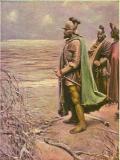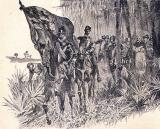Hernando De Soto
1496–1542 |
Hernando de Soto is best known today as the discoverer of the Mississippi River, but at the time, this was only minor incident in his long career as a Conquistador. De Soto arrived in the new world at at 18, and spent over 20 years in Central America before finally returning home in triumph, due to his leading part in the Conquest of Peru. After spending only a few years in Spain, he embarked on his most famous journey, a 2 year expedition covering much of the Southeastern United States. Although he made a name for himself by these exersions, the entire expedition, by the standards of his time, was a colossal failure. He sought gold and empire and found none.
De Soto was born after the New World was discovered. Since he came from a family of modest means, he desired to seek his fortune and left for the new world at an early age. De Soto accompanied Pedrarias Davila to Darien in 1514, shortly after Balboa had discovered the Pacific Ocean. For most of the next 15 years, De Soto was a faithful lieutenant of Pedrarias and followed him as he moved his capital from Darien to Panama City, and finally to Nicaragua. From his base in Leon, Nicaragua, de Soto launched an expedition up the Coast of the Yucatan, but found no gold there.
Shortly after the death of Pedrarias, De Soto joined the expedition led by Pizarro to conquer the Incan Empire. De Soto led the cavalry during the famous expedition, and might have been second in command but for a great deal of distrust between the two leaders. Their conflict grew even worse after Pizarro murdered the chief Inca, whom de Soto had befriended and sworn to protect, while De Soto was on a short expedition. De Soto spent over three years in Peru and returned to Spain in 1535 a national hero, and indescribably wealthy. At this time he married the daughter of Pedrarias and lived in luxury for several years.
After three years, however, De Soto hatched a plan to "conquer" Florida. His expedition was modeled after those of Cortez and Pizarro, and planned with great care. It was already known that the tribes along the coast were not civilized, and no gold had been found in the region, but he assumed that an inland empire must exist, and listened to any rumor of such a realm.
After embarking with 600 men and a great deal of equipment, De Soto landed in Western Florida and sent his ships home. From there he pressed on for two years during which he traveled thorugh Florida, Georgia, the Carolinas, Tennesee, Alabama, and Mississippi. The natives were generally unfriendly, and utterly impoverished. He followed every lead, and tried every method including extortion and grave robbing to gain riches for his men, but to no avail. The expedition met with disaster in Alabama at the hands of Chief Tuscaloosa, when he was unexpectedly ambushed. There was great loss of life on both sides, but the Spaniards finally prevailed, but only after the loss of most of their horses and supplies, and a great number of their men.
After two years of futile trekking, and a disastrous military loss, any sane man would have retreated to the Gulf of Mexico, less than 100 miles south, and searched for Spanish sailing ships. But De Soto could not acknowledge defeat and pushed on westward, to Arkansas, Louisiana, and Texas. It was during this final leg of the journey that he discovered the Mississippi, but his men only considered it another obstacle in the way of their search for empire. Mercifully, de Soto died a year later, and his remaining troops, amounting to less than half of the original 600, made their way over land to Mexico.
Key events during the life of Hernando de Soto:
| Born to a family of modest means near Jerez. | |
| Sailed to the new world with Pedrarias. Settled in Darien. | |
| Moved with Pedrarias to a new capital at Panama City. | |
| Helped conquer and explore Central America, serving und Pedrarias. | |
| Governed a region near Leon, Nicaragua | |
| Led an expedition up the coast of the Yucatan Peninsula. | |
| Led the Spanish cavalry during the Conquest of the Inca Empire | |
| The Inca Atahualpa was murdered over the objections of de Soto. | |
| Governor of the Province of Cuzco. | |
| Returned to Spain with immense riches. Married the daughter of Pedrarias. | |
| Began to outfit an expedition to 'Florida'. | |
| Landed his ships in Florida and disembarked. | |
| Wintered in the northern panhandle of Florida. The proceeded north through Georgia. | |
| Battle of Mauvila. Ambushed by Alabama Indians led by Chief Tuskaloosa. | |
| Wintered in Mississipi. Then crossed the River to Louisiana and Texas. | |
| Died and was buried at on the River. |
| Book Links |
|---|
Other Resources
| Early European Intercourse with the Indians in | Indian History for Young Folks by Francis S. Drake |
| De Soto and the Mississippi in | America First—100 Stories from Our History by Lawton B. Evans |
| The Father of Waters in | Story of the Thirteen Colonies by H. A. Guerber |
| How De Soto Came to the Father of Waters in | The Men Who Found America by Frederick Winthrop Hutchinson |
| De Soto and the Father of Waters in | Historical Tales: American II by Charles Morris |
Image Links | ||
|---|---|---|
 Fernando de Soto in Indian History for Young Folks |
 De Soto discovering the Mississippi in Indian History for Young Folks |
 Burial of de Soto in Indian History for Young Folks |
 De Soto's first view of the Mississippi in Story of the Thirteen Colonies |
 It was Ferdinand de Soto who first found this great river in The Men Who Found America |
 De Soto discovering the Mississippi in Historical Tales: American II |
 Ferdinand de Soto in Ferdinand De Soto and the Invasion of Florida |
 De Soto on the shore of the Mississippi in Ferdinand De Soto and the Invasion of Florida |
 Burial of De Soto in Ferdinand De Soto and the Invasion of Florida |
 Hernando de Soto in Builders of Our Country: Book I |
 Spanish Soldiers Making their way Through the Forests in Builders of Our Country: Book I |
 De Soto in the Inca's camp in The Adventures of Pizarro |
| With only 160 men, conquered six thousand Inca and took control of Peru. | |
| Choctaw chieftain who resisted de Soto at the Battle of Mauvila during his expedition through the southwest. | |
| Pedrarias Davila | First Governor of the Spanish colony of Darien in Peru. Murderous and unscrupulous rival of Balboa. |
| Helped establish a Spanish colony in Panama and discovered the Pacific Ocean. | |
| Juan Ortiz | Spaniard who had lived among natives for 10 years. Became invaluable translator for de Soto. |